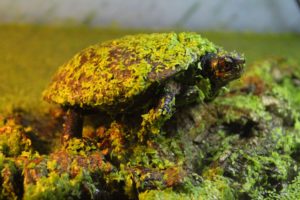SPOTTED TURTLEClemmys guttata
Conservation Status: Endangered
This is in large part due to their demand in the pet trade, but is also impacted by habitat loss and fragmentation, road mortality, and pollution. When marshlands are drained or deepened, this effects the spotted turtle. When small populations of these turtles are left, inbreeding occurs and they run a higher risk for effects from predation. All of this can lead to low recruitment (affects juvenile dispersal).

Learn More
Color:
This species is distinguished by bright yellow to orange spots on a smooth, brown-black shell. The head and limbs also have this coloration pattern. The head of the spotted turtle has a larger yellow or orange blotch on each side. The underside of the legs and neck are pink, salmon, or red in color while the underside of the shell is yellow or orange with dark patches on each scute (these patches grow larger with age).
Size:
Maximum length is 13.6 cm
Weight:
0.5 - 0.75 lbs
Average Lifespan:
30 years
Captive Lifespan:
40 years
Inhabits a fragmented range from southeastern Canada and the Great Lakes region (Southern Michigan) along the eastern coast of the US.
Prefers shallow bodies of water such as bogs, swamps, marshes, streams, and ponds. When on land, they prefer moist areas.
Mating:
Mating begins after winter and occurs in shallow water. The male will chase the female, nipping at her. Sometimes males will fight each other over rights to a female.
Gestation/Incubation:
Sperm is stored until needed to fertilize eggs. Nesting will occur in June, primarily at night.
Litter/Clutch Size:
A clutch will have 2-7 eggs. In the north, only about one clutch is laid. In the south, there may be 3 clutches.
Mature:
Eggs will hatch after 73-83 days. They reach maturity at 7-14 years.
The spotted turtle is an omnivore and will eat worms, slugs, snails, insects, crustaceans, tadpoles, fish, algae, leaves, and other aquatic plants
They will hibernate in the winter (sometimes together) at the bottom of a stream or river with a slow, steady flow of water. The spotted turtle will also aestivate (dormancy during hot temperatures similar to hibernation in winter) during the hot summer months, in the muddy bottoms of streams or in burrows. If threatened (by predators such as muskrats, raccoons, skunks, foxes, and dogs), they will dive to the bottom of the water and bury themselves in mud.
1. Males have brown eyes and a brown or black chin, while females have orange eyes and a yellow chin.
2. The sex of the hatchlings depends on temperature (cooler temp = male, warmer temp = female).
3. They can have anywhere from 0-100 spots on their bodies.


